Industry News, trenchless people, trenchless projects
When contractors provide estimates that include a sewer bypass, accuracy is essential—each project is unique, and accounting for these nuances is critical to maintaining margins. Failure to plan on the front end may lead to an influx of change orders and a big hit to the bottom line. Damages could go further than money alone: An estimating mistake might lead to a sanitary sewer overflow (SSO). Following an SSO, you can expect large sums for cleanup and DEQ penalties, along with negative PR and a ripple effect that could impact future projects.
Before submitting a bid, it’s critical to cover all the bases and avert potential problems on the job. The following lessons learned can help contractors avoid estimating mistakes, win bids, and complete projects at a profit—and without visits from the DEQ.
Lesson 1: Take a bottom-up approach to estimating.
Often estimators have little choice but to use unit costs, like cost per foot of pipe, for an estimate. But that doesn’t eliminate the need to check the latest prices. Inserting the cost from the last project without checking it seldom produces a safe number. Even if a job appears to be the same size and complexity as a previous project, treat every job individually and get a current price for every item.
Lesson 2: Always visit the project site with a knowledgeable individual.
Unforeseen site conditions are the largest contributor to project change orders and increased costs. Plans and drawings alone do not provide the information needed to route pipe, situate pumps, and manage flow for a sewer bypass. Avoiding this mistake is easy: Always visit the site with the engineer or a representative from the municipality—whoever has the most in-depth knowledge of the project. The sewer bypass subcontractor should also attend to explain the capabilities, as well as the limitations, of the pumping system. Consulting with the entire team will help ensure a solid quote for that portion of the contract.
Lesson 3: Insist on backup detail for subcontractor quotes.
Contracting firms often use subcontractors to design a sewer bypass for a larger project. Even if the subcontractor has complete confidence in the system as designed, never take their word that it will handle the sewer bypass flow for the cost they plan to charge. Instead, request the engineering calculations and system drawings, and then ask the design engineer to review them. Based on the information the subcontractor provides, the scope of equipment, system layout, and performance should be clear.
Lesson 4: Do due diligence on labor costs.
Labor costs often comprise the largest portion of a sewer bypass budget. Costs for prevailing wage and certified payroll add up quickly. Different project conditions can impact labor costs significantly, even for the same task. For example, a team working on a city street with heavy traffic may install less bypass piping each day than one working in an open field. Therefore, it’s critical to examine labor costs in detail over the project timeline, including hours and types of labor for each task. Then, make sure your bypass subcontractor offers a firm commitment on the cost.
Lesson 5: Factor in risk and the potential for lost revenue when accepting a low bid.
Although selecting the subcontractor with the lowest bid can be tempting, ultimately the project may cost more. Never assume a subcontractor will take responsibility for problems that result from lack of experience or expertise. Instead, consider all the worst-case scenarios that could occur, such as a sanitary sewer overflow. Ensure the subcontractor can manage each and every problem that may arise. Double check contract limitations and exclusions, the safety plan, and the spill and emergency response plan. In addition to liability considerations, it’s critical to review a bypass subcontractor’s bid to ensure it is complete. Have they included enough in labor costs to complete the project? Are fuel costs included, or even tax? Low bids may leave out these important components which can result in lost profits.
Lesson 6: Review the engineering submittal with the subcontractor.
To ensure all the estimate information is correct, always review the engineering submittal against the specifications with the subcontractor to make sure it matches the information in the request for quote. As a best practice, the engineering submittal should include not only the information required within the specifications, but also all the pertinent details about the temporary pumping system. It should be clear and concise so anyone who reads it will fully understand how the system is designed, set up, and operated. It should also have all the supporting documentation such as fluid calculations, drawings, and specification sheets on the equipment being used.
Checking the engineering submittal against the specifications will help to reduce or eliminate the engineer sending the submittal back for changes. Until the submittal is approved, the job cannot go forward, so in order to keep the project on track, it’s important to cross-check the documents before sending to the engineer.
Lesson 7: Assume the cost quoted can never be modified.
Do not count on subcontractors to take responsibility for problems and resolve them in a timely manner. The contractor is ultimately on the line and will be held to the amount put in every box on every bid. To be competitive, a firm’s margins must remain as low as possible while still providing a profit. If a quote does not include every item down to the last fitting and bolt, the margin and profit will suffer. The bypass subcontractor and firm should work together to determine the right costs to put into the bid tabulation sheet. Also, to avoid being buried in unanticipated invoices, be certain to incorporate a billing schedule with the bypass subcontractor that indicates when invoices will be received and what they are for.
Abiding by these seven lessons learned should avert many potential problems that occur in sewer bypass and ensure a winning bid that leads to a profitable and successful project.
For more information, visit www.sunbeltrentals.com or call 800-736-2504.
Blog, Industry News, trenchless projects
Compact TBM bores longest Rock Tunnel at 2.46 m Diameter
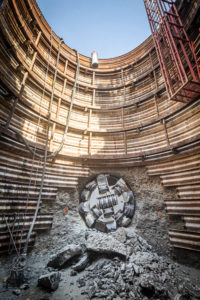 In August 2019, a small diameter Double Shield TBM made a big impact. The 2.46 m (8.07 ft) diameter Robbins machine completed 3,475 m (11,400 ft) of boring with no intermediate access, making it the longest rock tunnel ever bored by a Double Shield TBM under 2.5 m (8.2 ft) in diameter.
In August 2019, a small diameter Double Shield TBM made a big impact. The 2.46 m (8.07 ft) diameter Robbins machine completed 3,475 m (11,400 ft) of boring with no intermediate access, making it the longest rock tunnel ever bored by a Double Shield TBM under 2.5 m (8.2 ft) in diameter.
The machine completed the Parmer Lane Wastewater Interceptor in Austin, Texas, USA for contractor S.J. Louis Construction. Despite obstacles including two tight curves of 150 m (500 ft) radius and unexpected ground conditions that required modification of the cutterhead in the tunnel, advance rates were good. The machine reached up to 380 m (1,250 ft) per month while mining in single 12-hour shifts per day. “It was a hard rock TBM, and it performed better than expected through hard rock,” said Zach West, Project Manager for S.J. Louis.
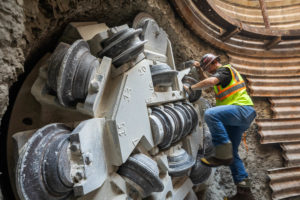
The challenges for the TBM and its crew were varied, explained West. “The pairing of this tunnel length, which is on the longer side, and the diameter, which is on the smaller side, is challenging. The survey in a small tunnel with tight radius curves and limited surface access for over two miles is very difficult.” He added that the shallow tunnel depth, and the alignment to within a few feet of sanitary lines, high-pressure gas mains, and fuel tanks for gas stations, made TBM guidance critical. “I would say that I am most proud of our ability to guide the machine successfully through these obstacles and into our retrieval shaft within our expected tolerances.”
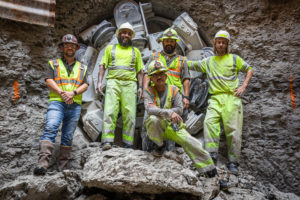 Through one stretch, the tunnel advanced directly between a 30 cm (12 in) diameter, high-pressure gas main and fuel tanks for a gas station with limited as-built information. “Navigating this section took a great deal of coordination with the local utility companies. Because the tunnel diameter was too small for an automated guidance system, we manually surveyed the front of the machine at every push to ensure the machine was on track,” said West.
Through one stretch, the tunnel advanced directly between a 30 cm (12 in) diameter, high-pressure gas main and fuel tanks for a gas station with limited as-built information. “Navigating this section took a great deal of coordination with the local utility companies. Because the tunnel diameter was too small for an automated guidance system, we manually surveyed the front of the machine at every push to ensure the machine was on track,” said West.
“I’m proud that they mined the longest tunnel to date for a small shielded gripper machine of this size without any safety issues. Kudos to their management philosophy and jobsite team,” said Tom Fuerst, Robbins Utility Tunneling Sales Manager. Robbins assisted the crew while in the tight 150 m (500 ft) curves and helped with modifications required to the cutterhead and disc cutter arrangement.
 The tunnel is located in an environmentally sensitive aquifer, with ground conditions ranging from soft dolomite with clay to limestone from 13 to 68 MPa (2,000 to 10,000 psi) UCS. “While we tunneled through the softer material, our best advance rate was close to 0.9 m (3 ft) per hour. When we tunneled through the expected limestone, advance rates were over 5.2 m (17 ft) per hour. Our best day was 25 m (81 ft) in a single shift,” said West.
The tunnel is located in an environmentally sensitive aquifer, with ground conditions ranging from soft dolomite with clay to limestone from 13 to 68 MPa (2,000 to 10,000 psi) UCS. “While we tunneled through the softer material, our best advance rate was close to 0.9 m (3 ft) per hour. When we tunneled through the expected limestone, advance rates were over 5.2 m (17 ft) per hour. Our best day was 25 m (81 ft) in a single shift,” said West.
The majority of the tunnel used a simple two-rock-bolt pattern for support. In the last 10% of the tunnel, ribs and lagging were used as support. Final carrier pipe, which is now being installed, consists of 110 cm (42 in) diameter fiberglass pipe.
The successful project is part of a larger trend towards small diameter, TBM-driven rock tunnels in the United States, says Fuerst. “It is primarily due to demographics and business growth. The parts of the USA that are growing need to build out their sewer and water infrastructure. TBMs can mine long distances with tight curves. They can reduce the need for multiple shafts, which lowers the overall project cost. And, given that most small diameter pipelines follow a road or municipal right-of-way, traffic problems are reduced significantly compared with open cut operations.”
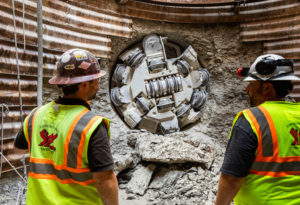 The Parmer Lane Wastewater Interceptor connects to two existing lift stations at Lake Creek and Rattan Creek. The tunnel allows for these lift stations to be decommissioned, and will provide additional flow capacity by gravity, reducing operating costs for the City of Austin.
The Parmer Lane Wastewater Interceptor connects to two existing lift stations at Lake Creek and Rattan Creek. The tunnel allows for these lift stations to be decommissioned, and will provide additional flow capacity by gravity, reducing operating costs for the City of Austin.
Image 1: Completed in August 2019 with a Robbins Double Shield TBM, the Parmer Lane Wastewater Interceptor will provide additional flow capacity via gravity in Austin, Texas, USA.
Image 2: The 3,475 m (11,400 ft) tunnel bored by a Robbins TBM is the longest ever bored by a Double Shield machine under 2.5 m (8.2 ft) in diameter.
Image 3: The S.J. Louis Construction crew celebrate the successful and safe completion of the Parmer Lane Wastewater Interceptor with a Robbins TBM.
Image 4: Tom Fuerst, Robbins Utility Tunneling Sales Manager, celebrates as he exits the TBM during its August 2019 breakthrough in Austin, Texas, USA.
Image 5: The Robbins TBM bored through dolomite with clay and limestone at rates of up to 380 m (1,250 ft) in one month while mining in single 12-hour shifts per day.
Industry News, The No-Dig Show, trenchless people
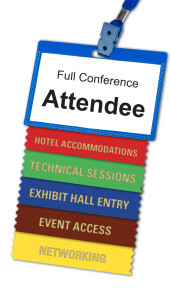
 The North American Society for Trenchless Technology (NASTT) — the leading association serving and promoting the North American trenchless industry — is pleased to announce municipal and public utility scholarship opportunities to attend the NASTT 20202 No-Dig Show, April 5-9 in Denver, Colorado.
The North American Society for Trenchless Technology (NASTT) — the leading association serving and promoting the North American trenchless industry — is pleased to announce municipal and public utility scholarship opportunities to attend the NASTT 20202 No-Dig Show, April 5-9 in Denver, Colorado.
In 2013, NASTT established the No-Dig Show Municipal & Public Utility Scholarship Award Program to provide education and training for employees of North American municipalities, government agencies and utility owners who have limitedor no training funds due to economic challenges. In past years, over 100 applicants were awarded the scholarship annually.
“The NASTT Municipal & Public Utility Scholarship offers public agencies the opportunity in which to participate and experience the world of trenchless. Since its inception in 2013, scholarships have been awarded to more than 850 applicants, and the success of the program continues to increase every year.” said Joe Lane, 2020 No-Dig Show Program Chair and V.P. of International Operations for Insituform. “With an entire show dedicated to trenchless technology, this scholarship is a tremendous opportunity for municipal & public utility employees to attend at little or no cost.”
Selected scholarship winners will be awarded Full Conference and Exhibition registration to the NASTT 2020 No-Dig Show. Also available are one day conference registrations which include full access to all exhibits and technical paper sessions. Selected applicants will also be eligible to receive complimentary overnight accommodations for three nights at the host hotel. The scholarship applications are reviewed by a committee of NASTT volunteers and awarded based upon the supplied responses.
To apply for the scholarship, complete the application online at
nastt.org/no-dig-show/municipal-scholarships on or before November 1, 2019. Applicants are not required to be NASTT members.
NASTT’s Municipal & Public Utility Scholarships program is sponsored by Benjamin Media, Inc, award-winning publisher of the leading underground construction magazine, Trenchless Technology.
For more information about NASTT’s No-Dig Show visit www.nodigshow.com, email conferences@benjaminmedia.com or call 330-467-7588.
Industry News, trenchless people
 Zahra (Ellie) Kohankar Kouchesfehani is a Ph.D. Student and Graduate Research and Teaching Assistant at the Center for Underground Infrastructure Research and Education (CUIRE) in the Department of Civil Engineering at The University of Texas at Arlington. She is a NASTT Student Chapter Member and a valuable volunteer at our annual No-Dig Show.
Zahra (Ellie) Kohankar Kouchesfehani is a Ph.D. Student and Graduate Research and Teaching Assistant at the Center for Underground Infrastructure Research and Education (CUIRE) in the Department of Civil Engineering at The University of Texas at Arlington. She is a NASTT Student Chapter Member and a valuable volunteer at our annual No-Dig Show.
We are excited that Zahra’s submission, “Structural Design Methodology for Spray Applied Pipe Liners in Gravity Storm Water Conveyance Conduits as a Trenchless Renewal Application,” has been selected for an ISTT 2019 No Dig Award.
The selection team found the methodology to be a significant contribution to the trenchless world.
The award will be recognized at the Gala Dinner and Awards Ceremony on October 1, 2019 at the 37th International No Dig Conference in Florence, Italy.
Congratulations, Zahra!
Industry News, trenchless products
Perfect for hard rock and fractured ground formations
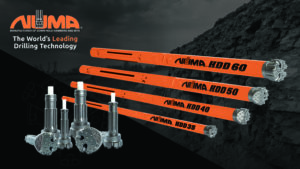 THOMPSON, CONNECTICUT USA, August, 2019:
THOMPSON, CONNECTICUT USA, August, 2019:
Numa, the world’s leading drilling technology provider, has released a range of HDD Drilling Systems designed for productive and efficient drilling in hard rock and fractured ground formations.
“Numa has a long history of serving the HDD market and with our range of HDD Drilling Systems we enhance our ability to serve our customers with the right products for the job,” said Numa President, Ralph Leonard. “Our high quality, Made in the USA HDD products provide the right balance of performance and dependability without sacrificing tool life.”
Numa’s HDD Drilling Systems consist of a variety of HDD components including hammers, bits, side load sonde housings, bent subs, and adaptors which are capable of drilling holes 4″ to 7-1/2″ (102 mm to 191 mm) in diameter. Some of the many benefits Numa touts for the HDD hammer line include: improved steerability, fast penetration rate, simplified field maintenance, reduced air requirements, and lower overall cost per foot.
With deep experience in rock drilling, Numa purposely designed their HDD hammers to drill longer in difficult rock conditions. Furthermore, a single bore design allows for a maximum bore diameter in conjunction with providing optimum life against abrasion. The full line of Numa’s HDD Drilling Systems is made up of the models indicated below with a full description on their website product page.
- HDD 35 for drilling holes 3-7/8” to 4” (98 mm – 102 mm) in diameter
- HDD 40 for drilling holes 4-3/4” to 5” (121 mm – 127 mm) in diameter
- HDD 50 for drilling holes 5-3/4” to 6-1/8” (146 mm – 156 mm) in diameter
- HDD 60 for drilling holes 7″ to 7-1/2″ (178 mm – 191 mm) in diameter
Numa will be featuring their HDD Drilling Systems in booth #1905 at the ICUEE 2019 show happening October 1-3 in Louisville, Kentucky.
ABOUT NUMA
Numa is the world’s leading drilling technology provider, dedicated to ongoing product innovation and results-oriented consistency. We’ve built a strong legacy of high quality, U.S. made hammers and bits for drilling holes 3½ – 50½ inches (89 -1283 mm) in diameter. With over 100 hammer and bit products serving 11 different industries, our products are capable of drilling vertical, horizontal, and reverse circulation holes in hard rock and unconsolidated formations.
Industry News, trenchless people
 Longtime underground construction and trenchless industry professional Davis Yates passed away Tuesday, July 2, 2019 at the age of 51. Through his career Yates worked at trenchless equipment manufacturer TT Technologies, Aurora, Ill., Mocon Corp., Southern California HDPE pipe, fitting and fusion supplier Maskell-Robbins, as well as a variety trenchless and underground contractors along the West Coast.
Longtime underground construction and trenchless industry professional Davis Yates passed away Tuesday, July 2, 2019 at the age of 51. Through his career Yates worked at trenchless equipment manufacturer TT Technologies, Aurora, Ill., Mocon Corp., Southern California HDPE pipe, fitting and fusion supplier Maskell-Robbins, as well as a variety trenchless and underground contractors along the West Coast.
Yates trained many people throughout his career in the proper use of various boring, tools, pipe rammers and pipe bursting systems. He was an energetic and innovative individual whose way of getting the job done was very much appreciated by those he worked with over the years.
Always an innovator, always creative and always seeing the job through, he became great friends with many of the people he worked with in the field and will be missed by many.
Yates leaves behind two children, Jenna, 13 and Marcus, 11. A Go Fund Me page has been established to help with the expenses of his children’s future education, as well as the planting of a remembrance tree. Donations will be placed into a savings plan for both Jenna and Marcus.
The Go Fund Me Page can be found here: https://www.gofundme.com/f/jenna-and-marcus-dad
Industry News, trenchless people
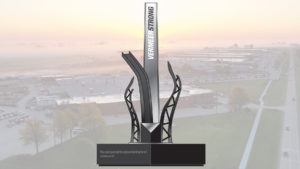 PELLA, IA – Recently, Vermeer Corporation held the groundbreaking for a monument commemorating the buildings destroyed by an EF3 tornado last July (2018), while celebrating the strength of the Vermeer team and the growth and progress that is happening along the Vermeer Mile.
PELLA, IA – Recently, Vermeer Corporation held the groundbreaking for a monument commemorating the buildings destroyed by an EF3 tornado last July (2018), while celebrating the strength of the Vermeer team and the growth and progress that is happening along the Vermeer Mile.
“The tornado was the greatest challenge Vermeer has ever faced. I am incredibly proud to say our team has turned it into an opportunity. Not only are we rebuilding what we had, but we’re becoming stronger than ever before,” said President and CEO Jason Andringa.
With three new facilities underway at the Pella-based headquarters, Vermeer is investing heavily in the future.
The first facility scheduled to open this summer is a new engineering and R&D building named Shop 48. The name stems from Founder Gary Vermeer’s shop where his innovations came to life and led to the founding of Vermeer Corporation in 1948. With more than 100,000 square feet of space dedicated to building and testing new equipment, team members will begin to move into this space in August.
“We’re very fortunate at Vermeer to have a 71-year history of innovation. Shop 48 will take our innovation and growth opportunities long into the future,” said President of Industrial Solutions Doug Hundt.
Plant 7 was formally announced as the new facility being built where Plants 5 & 6 once stood. Nearly 500,000 square feet of manufacturing and office space will expand beyond the original manufacturing footprint that took up just less than 400,000 square feet of this area. The new facility will connect to the original Plant 7 that was damaged in the tornado but repaired in the months following. Together, they will take on the name Plant 7. Scheduled to be completed in fall 2020, this facility is being built to keep team members safe at every touchpoint on the job, create ultimate productivity, be a collaborative and engaging space for team members and allow for growth long into the future. Incorporating advanced manufacturing techniques and continuous improvement best practices will help drive world-class manufacturing. “Looking ahead, this facility is going to be world-class in every feature. We’re advancing our paint technology, coat technology and the space for our team,” said Vice President of Operations Bill Blackorby.
Also recognized was the new Eco Center. Replacing the one lost in the tornado, the new building will be placed behind Plant 1 and open its doors in January 2020. The Eco-Center helps responsibly process and manage waste along the Mile.
“Our customers depend on our ability to get high-quality equipment to them – this new facility makes us excited to continue to deliver on this promise into the future,” said Executive Vice President of Forage and Lifecycle and Chief Marketing Officer Mark Core.
About Vermeer Corporation
Vermeer delivers a real impact in a progressing world through the manufacture of high-quality agricultural, underground construction, surface mining, tree care and environmental equipment. With a reputation for durability and reliability, that equipment is backed by localized customer service and support provided by independent dealers around the world. To learn more about Vermeer, products, the dealer network and financing options, visit Vermeer.com.
Industry News, trenchless people
 The NASTT Trenchless Family has lost friend and colleague, Tom Perry, a member of the Northeast Regional Chapter Board of Directors.
The NASTT Trenchless Family has lost friend and colleague, Tom Perry, a member of the Northeast Regional Chapter Board of Directors.
Thomas Perry of Mt. Olive Township, NJ passed away Friday July 26, 2019 at Morristown Medical Center in Morristown after a short illness. He was 58.
Tom was born in Pequannock, NJ and lived in Mt. Olive Township for 21 years.
A graduate of Pequannock High School and Montclair State University, Tom was the owner of Multi Utilities Ventures in Mt. Olive Township.
Beloved husband of Jean (nee: Miller) Perry. Devoted father of Erin and Megan Perry. Loving son of Doris (nee: Peacock) Perry and the late Raymond Perry. Dear brother of Jim Perry, Peggy Perry, Doreen Sprules , Mary Beth Wyant , Jean Wallace, Michele Bucek, the late Lee Perry, Ricky Perry, Linda Perry and Janice Moebius. Also survived by many nieces and nephews.
We would like to extend our condolences to the Perry Family and to the many friends in our industry that loved Tom.
Memorial donations may be made to the National Pancreatic Cancer Fund, PO Box 1848, Longmont, CO 80502.
Industry News, trenchless people
 The trenchless industry lost a founding member with the recent passing on July 8 of James (Jim) Barbera at the age of 79. James Barbera founded Barbco Inc. in 1989. Today, the company leads the auger-boring industry with equipment that promotes safety and efficiency, such as the TriBor, Flexbor and Pathfinder.
The trenchless industry lost a founding member with the recent passing on July 8 of James (Jim) Barbera at the age of 79. James Barbera founded Barbco Inc. in 1989. Today, the company leads the auger-boring industry with equipment that promotes safety and efficiency, such as the TriBor, Flexbor and Pathfinder.
In November of last year, the Trenchless Technology Center (TTC) at Louisiana Tech University honored James and his brother Leo with lifetime achievement awards for their contributions to the trenchless industry. During the award celebration TTC also unveiled the Barbera Underground Infrastructure Research and Training (BUIRT) Facility. Named in honor of the Barbera family, this state-of-the-art facility will offer research, training and development for the trenchless technology industry.
Barbco has been a generous supporter of NASTT and the trenchless industry throughout the years and their involvement has been very important to us. We send our condolences to the Barbera Family and the team at Barbco.
Image: Jim Barbera and his wife Fran
trenchless people, trenchless projects
When a municipality puts out an RFQ for an engineering project and includes the following words—design a temporary sanitary sewer bypass system as needed to construct improvements—design engineers need to focus on two tasks: defining the scope and designing the solution. But typically, sewer bypass is just one part of a much larger project, and often design engineers aren’t trained in sewer bypass design. Fortunately, you can ask for help from bypass subcontractors and rental companies. That way, when your engineering firm helps the municipality take the project out for bid, estimators will be working with solid information that will help ensure reasonable bids.
The goal is to scope and design quickly, accurately, and effectively to avoid expensive mistakes and delays. Read on for a how-to guide to help you get it right.
Define the Scope
Before listing the steps to define the scope, let’s define what project scope actually means.
Projects are time-constrained undertakings to produce a product, service, or result. The scope defines the purpose, the ultimate goal, and how you will achieve it. Scope also determines the boundaries—what’s included in the project and what’s not. If you fail to define scope adequately, your project will likely end up over budget and behind schedule.
According to the Project Management Institute, scope changes are the single biggest reason projects fail. If the scope becomes a moving target, you’re increasing the chance for the project and your career to take a nosedive.
Here are six steps to help you thoroughly define the project scope.
- Provide an overall project description. The project description should include what the municipality wants to accomplish, the current sewer capacity, equipment in use, location and layout of existing facilities, and duration of the project. You may also want to note challenges, such as existing buildings, roads, and other structures, or areas of environmental concern such as creek crossings.
- Explain the driving forces. Billions of dollars in federal aid have been made available to rehabilitate decaying sewer systems. Many municipalities have taken advantage of the funds to initiate rehabilitation projects, whether for sewer lines, lift stations, or wastewater treatment plants. Or the municipality may be working under a consent decree that mandates specific improvements to a sewer system by a deadline.
- Specify the deliverables. The municipality’s requirements may list the details of sewer system improvements. But often the sewer bypass system itself simply directs you to design a system that will allow the improvements to be made without an interruption of service. It’s up to you to determine the requirements and provide the specifications.
- Determine the boundaries. Based on the improvements the municipality intends to make, you’ll need to determine exactly what the sanitary sewer bypass system should look like to meet the sewer requirements for as long as the project is active. For example, you’ll need to determine if the temporary system must operate at all times during construction, if it can be tied into the existing sanitary sewer system overnight, if the existing sanitary sewer system can be returned to normal flow for long periods, and if the flow can be partially diverted or must be fully diverted.
- State your assumptions. Define the conditions you’re assuming and their impact on the project. For example, the municipality may claim sandy soil in an area. If it’s actually rocky, you’ll be less productive while dealing with unexpected soil conditions. That will impact project time and cost, and generate a change order.
- List uncertainties and potential impacts. Uncertainties create risk and cost money. For example, you need to know up front of any time limitations on when work can be performed to complete the project. You also need to be aware of physical obstructions such as rivers and streams, railroad crossings, parks, and public and private property the sewer bypass may need to cross.
Design the Solution
Your bypass system design needs to be as detailed as possible, or you risk change orders, higher costs, and a damaged reputation. You may want to rely on a bypass subcontractor and/or rental company to help you specify accurately. In addition, technology continues to evolve, and the design should allow the project to meet the highest standards at the lowest cost in the shortest amount of time.
If you’ve established a partnership with a company with expertise in designing sewer bypass systems, you’re a step ahead. You can provide the known parameters to the bypass subcontractor or pump rental company and receive a sewer bypass design in return. For parameters that the municipality can’t provide, your partner can go on site and fill in missing pieces of engineering data to ensure the designed system will operate as intended. A bypass subcontractor will typically provide you with a quote up front, but you normally won’t receive the engineering submittal until after you sign a contract. The engineering submittal and drawings should show exactly how they’ll perform the project and what assumptions they’ve used to make calculations. You can take that back to the municipality for confirmation.
To keep your plans for a sewer bypass on point, here’s a list of the key requirements and where you can get the information to specify them.


We hope this guide will help you better define the scope and design the solution for sewer bypass projects. But you don’t have to go it alone. It helps to work with a partner that can not only provide high-quality equipment and accessories, but engineering knowledge and installation expertise.
Interested in learning more? Join Sunbelt Rentals for a free webinar with Trenchless Technology on August 15, 2019 at 2 pm EST. Register here







 The North American Society for Trenchless Technology (NASTT) — the leading association serving and promoting the North American trenchless industry — is pleased to announce municipal and public utility scholarship opportunities to attend the NASTT 20202 No-Dig Show, April 5-9 in Denver, Colorado.
The North American Society for Trenchless Technology (NASTT) — the leading association serving and promoting the North American trenchless industry — is pleased to announce municipal and public utility scholarship opportunities to attend the NASTT 20202 No-Dig Show, April 5-9 in Denver, Colorado.






